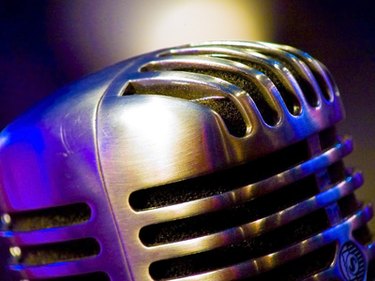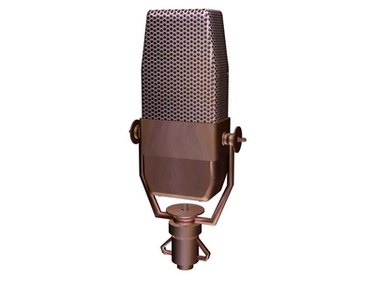
A microphone is a relatively simple device: you speak into it, and it picks up sound and puts it out through a speaker. However, microphones have a long, winding history both in and out of radio station studios.
Dynamic
Video of the Day

Dynamic microphones are the most recognizable type of microphones: they are the handheld models used by singers on stage. In a radio studio, they would most likely be used in the event that a band played a song in the studio. Or, if a reporter went out into the field for a news report, he would use the dynamic mic because of its portability.
Video of the Day
Capacitor/Condensor

One of the oldest types of microphones is the capacitor (also known as condensor) microphone. These are the microphones that come to mind when thinking of a radio studio: the DJ talks into the microphone that is being held by a long arm-like contraption. Capacitor microphones are good for quiet settings, which is why they are the most commonly used microphones in radio studios. They are generally more efficient, but also more expensive than dynamic mics.
Electret

Electret mics are a type of capacitor microphone. They are much smaller than their capacitor counterparts, and are a bit cheaper. Because of their lower-quality sound, they haven't had much popularity with radio stations, as many stations have opted to spend a little extra for the better technology of the capacitor mic.
Carbon

The carbon microphone conjures up images of old jazz joints, with the singer belting a song into the big, silver metal mic. You may also recognize carbon mics as the microphones that are lowered from the ceiling to the man standing in the middle of a boxing ring, waiting to announce the participants. Popular in radio stations during the early 20th century, technology surpassed the carbon mic and has made it mostly obsolete, despite its classic look.
Ribbon

Ribbon microphones have a very similar look to capacitor mics, and are just as old. Very popular with radio stations in the 1920s and 1930s (where they replaced carbon mics), ribbon mics are a type of velocity microphone. They are directional in nature, meaning that you must point them towards the sound you are hoping to pick up. Early models were very frail, but newer technology has helped their durability.
Crystal

Back in grade school, whenever you heard your principal's voice coming from the speakers above, she was usually speaking into a crystal microphone. Not as durable as other mics, crystal microphones were perfect for simple applications, such as these morning announcements. In the 1930s, they were very popular among AM ham radio operators and other amateur radio stations.